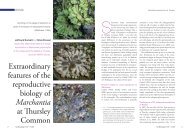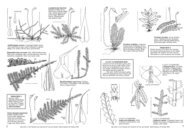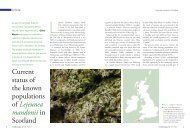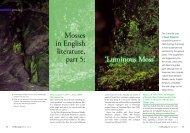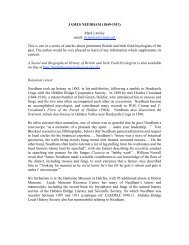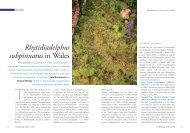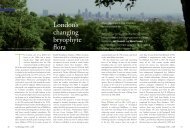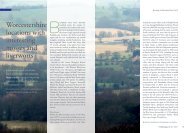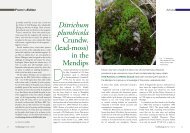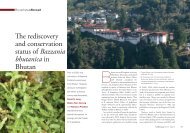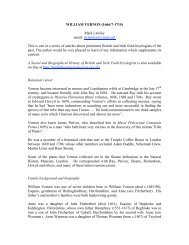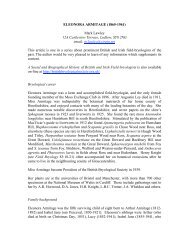Bryological Monograph An annotated checklist of the mosses of ...
Bryological Monograph An annotated checklist of the mosses of ...
Bryological Monograph An annotated checklist of the mosses of ...
Create successful ePaper yourself
Turn your PDF publications into a flip-book with our unique Google optimized e-Paper software.
DNA sequencing to understand basic relationships. This<br />
has revolutionized <strong>the</strong> systematics <strong>of</strong> land plants and<br />
resulted in a new classification <strong>of</strong> <strong>mosses</strong>.<br />
The immediate stimulus for producing a new list <strong>of</strong><br />
European <strong>mosses</strong> came from a meeting <strong>of</strong> <strong>the</strong> European<br />
Committee for Conservation <strong>of</strong> Bryophytes (ECCB) in<br />
Valencia, Spain, in September 2004. They intend to produce<br />
an updated Red List <strong>of</strong> European bryophytes. For this<br />
activity it is necessary to have an updated <strong>checklist</strong>. There<br />
was no immediate need for a new list <strong>of</strong> Hepaticae and<br />
<strong>An</strong>thocerotae, which had been revised by Grolle & Long<br />
(2000). Mosses were <strong>the</strong> priority.<br />
A project to make a new <strong>checklist</strong><br />
After some consultation, M.O.H. was persuaded to coordinate<br />
production <strong>of</strong> <strong>the</strong> new list. He proposed a project lasting<br />
for <strong>the</strong> year 2005. It was given <strong>the</strong> name EuroMoss2005 and<br />
had its own website. A Steering Group consisting <strong>of</strong> Michele<br />
Aleffi (Italy), Bill Buck (USA), Montserrat Brugués (Spain),<br />
Klaus Dierssen (Germany), Misha Ignatov (Russia), Lars<br />
Söderström (Norway) and Jirˇí Váňa (Czech Republic)<br />
guided <strong>the</strong> project. It played a crucial role from <strong>the</strong> start,<br />
notably in giving <strong>the</strong> project sufficient gravitas to attract<br />
authors who were experts in particular groups.<br />
The project <strong>the</strong>n proceeded in three stages. The first stage<br />
was to construct a provisional list, including synonyms, for<br />
experts to work from. For this, <strong>the</strong> ECCB supplied M.O.H.<br />
with an initial <strong>checklist</strong>, which was cross-referenced to <strong>the</strong><br />
world list <strong>of</strong> Crosby et al. (1999). National and regional lists<br />
produced since about 1995 were <strong>the</strong>n searched for names and<br />
additional taxa. Many lists were available as electronic<br />
documents, ei<strong>the</strong>r posted on <strong>the</strong> internet or sent by e-mail.<br />
Members <strong>of</strong> <strong>the</strong> Steering Group acted as scouts, seeking as<br />
complete a species list as possible. The output <strong>of</strong> <strong>the</strong> first stage<br />
was a provisional list <strong>of</strong> names, some <strong>of</strong> which had authorities,<br />
toge<strong>the</strong>r with synonyms that had recently been used in Europe.<br />
At <strong>the</strong> next stage, experts (Table 1) were each sent a<br />
provisional list <strong>of</strong> names and synonyms for <strong>the</strong>ir group, and<br />
Table 1. Experts contributing text for particular families; for <strong>the</strong><br />
authorship <strong>of</strong> <strong>the</strong> paper, contributors o<strong>the</strong>r than <strong>the</strong> coordinator are<br />
listed alphabetically, with no attempt made to distinguish <strong>the</strong> magnitude<br />
<strong>of</strong> <strong>the</strong>ir contribution.<br />
Family or families Expert or experts<br />
Sphagnaceae Flatberg<br />
Polytrichaceae Hyvönen, Bell<br />
Funariaceae Brugués<br />
Grimmiaceae (except Schistidium) Muñoz<br />
Fissidentaceae Bruggeman-Nannenga<br />
Dicranales (except Fissidentaceae) Frahm<br />
Pottiaceae Guerra, Cano, Gallego<br />
Orthotrichaceae Lara, Garilleti, Mazimpaka<br />
Bryaceae Holyoak<br />
Amblystegiaceae, Calliergonaceae Hedenäs<br />
Brachy<strong>the</strong>ciaceae Ignatov<br />
Neckeraceae, Lembophyllaceae Enroth<br />
MOSSES OF EUROPE AND MACARONESIA 199<br />
were asked to convert <strong>the</strong> provisional list into one<br />
conforming to <strong>the</strong>ir own ideas. This process resulted in<br />
most <strong>of</strong> <strong>the</strong> major groups having been reviewed by one or<br />
more experts. The gaps were filled by <strong>the</strong> coordinator and<br />
Pr<strong>of</strong>essor Söderström, with advice from o<strong>the</strong>r bryologists<br />
who are thanked in <strong>the</strong> acknowledgements.<br />
When <strong>the</strong> list was nearly complete, doubtful species were<br />
reviewed in detail by <strong>the</strong> Steering Group, to ensure that<br />
<strong>the</strong>y received reasonably consistent treatment. At <strong>the</strong> final<br />
stage, <strong>the</strong> information was loaded into databases (a<br />
database <strong>of</strong> names, ano<strong>the</strong>r <strong>of</strong> annotations and a third<br />
with <strong>the</strong> bibliography) and reformatted for publication.<br />
Information published in papers after 2005 was not<br />
accepted for this list, which presents <strong>the</strong> state <strong>of</strong> knowledge<br />
on 31 December 2005.<br />
The area <strong>of</strong> <strong>the</strong> <strong>checklist</strong><br />
Europe is defined basically as that part <strong>of</strong> <strong>the</strong> land mass <strong>of</strong><br />
Eurasia bounded in <strong>the</strong> east by <strong>the</strong> Ural mountains and<br />
Ural River, and in <strong>the</strong> south by <strong>the</strong> Caucasus mountains<br />
and <strong>the</strong> Mediterranean and Black seas (cf. Söderström,<br />
Urmi & Váňa, 2002). Defined thus, it includes <strong>the</strong><br />
Caucasian parts <strong>of</strong> <strong>the</strong> Russian Federation but excludes<br />
Georgia and Azerbaijan. It includes Turkey-in-Europe,<br />
western Kazakhstan, and all <strong>the</strong> Greek islands. It excludes<br />
<strong>An</strong>atolia and Cyprus. In <strong>the</strong> Arctic, Novaya Zemlaya and<br />
Franz Josef Land are included (excluded by Corley et al.,<br />
1981), as well as Svalbard and Jan Mayen. The Atlantic<br />
islands <strong>of</strong> Iceland and <strong>of</strong> Macaronesia (Canaries, Madeira<br />
and Azores but not Cape Verde) are included.<br />
Nomenclature and taxonomy<br />
With some exceptions, <strong>the</strong> names listed here are those<br />
included in European <strong>checklist</strong>s from about 1995, toge<strong>the</strong>r<br />
with names from <strong>the</strong> world list <strong>of</strong> Crosby et al. (1999).<br />
Earlier names are ignored. This means, fortunately, that<br />
<strong>the</strong>re are exceedingly few cases where a name is ambiguous,<br />
with different significance depending on authorities.<br />
The more important subspecies and varieties have been<br />
included, but <strong>the</strong>re is no intention to include varieties that<br />
are not generally recognized.<br />
No attempt has been made to give a comprehensive<br />
catalogue <strong>of</strong> moss hybrids. Hybrid taxa are mentioned in<br />
<strong>the</strong> notes only if <strong>the</strong>y have been treated in recent lists.<br />
At <strong>the</strong> time <strong>of</strong> writing, moss taxonomy is being strongly<br />
affected by <strong>the</strong> results <strong>of</strong> studies using molecular methods<br />
and detailed anatomical analysis. In <strong>the</strong> present list for<br />
Europe, we have adopted a standpoint that might be<br />
characterized as moderately conservative. Thus we have<br />
accepted new generic concepts in Amblystegiaceae (mainly<br />
due to Hedenäs) and in Brachy<strong>the</strong>ciaceae (mainly due to<br />
Ignatov and Huttunen). However, in Bryaceae, Hypnaceae,<br />
Plagio<strong>the</strong>ciaceae, Pottiaceae and several related small



